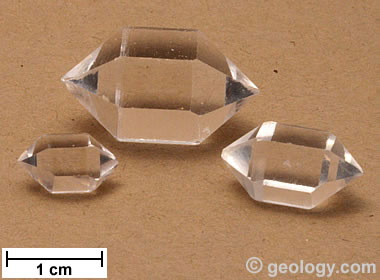

Quartz crystals: Herkimer "Diamond" quartz crystals. A clear, "rock crystal" variety of quartz.
Quartz is a mineral composed of silicon and oxygen, with a chemical composition of SiO2. It is the most abundant mineral in Earth's crust and is resistant to both chemical and physical weathering. When rocks weather away, the residual material usually contains quartz. This is why the sand at most of the world's beaches is quartz.
ADVERTISEMENTQuartz is the most abundant and widely distributed mineral found at Earth's surface. It is present and plentiful in all parts of the world. It forms at all temperatures. It is abundant in igneous, metamorphic, and sedimentary rocks. It is highly resistant to both mechanical and chemical weathering. This durability makes it the dominant mineral of mountaintops and the primary constituent of beach, river, and desert sand. Quartz is ubiquitous, plentiful and durable. Minable deposits are found throughout the world.
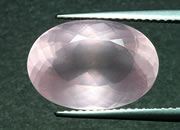
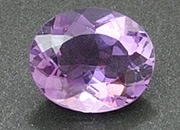
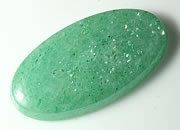
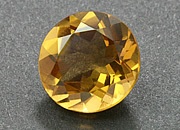
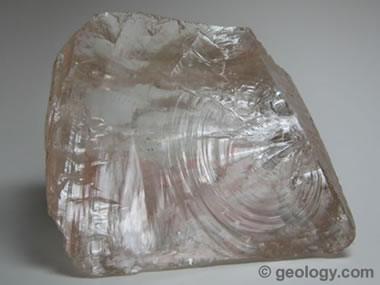
Rock crystal quartz: Transparent "rock crystal" quartz. This specimen shows the conchoidal fracture (fracture that produces curved surfaces) that is characteristic of the mineral. Specimen is about four inches (ten centimeters) across and is from Minas Gerais, Brazil.
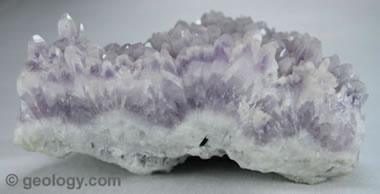
Amethyst quartz: Purple crystalline quartz is known as "amethyst." When transparent and of high quality, it is often cut as a gemstone. This specimen is about four inches (ten centimeters) across and is from Guanajuato, Mexico.
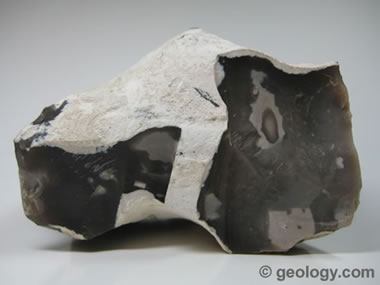
Flint: Flint is a variety of microcrystalline or cryptocrystalline quartz. It occurs as nodules and concretionary masses and less frequently as a layered deposit. It breaks consistently with a conchoidal fracture and was one of the first materials used to make tools by early people. They used it to make cutting tools. After thousands of years, people continue to use it. It is presently used as the cutting edge in some of the finest surgical tools. This specimen is about four inches (ten centimeters) across and is from Dover Cliffs, England.
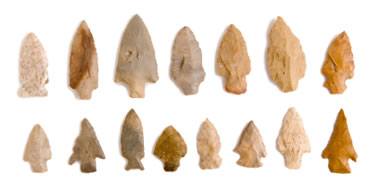
Quartz flint arrowheads: One of the first uses of quartz, in the form of flint, was the production of sharp objects such as knife blades, scrapers, and projectile points such as the arrowheads shown above. Image copyright iStockphoto / Leslie Banks.
Quartz is one of the most useful natural materials. Its usefulness can be linked to its physical and chemical properties. It has a hardness of seven on the Mohs Scale which makes it very durable. It is chemically inert in contact with most substances. It has electrical properties and heat resistance that make it valuable in electronic products. Its luster, color, and diaphaneity make it useful as a gemstone and also in the making of glass.
Geological processes have occasionally deposited sands that are composed of almost 100% quartz grains. These deposits have been identified and produced as sources of high-purity silica sand. These sands are used in the glassmaking industry. Quartz sand is used in the production of container glass, flat plate glass, specialty glass, and fiberglass.

Quartz glass windows: Glassmaking is one of the primary uses of quartz. Image copyright iStockphoto / Chinaface.
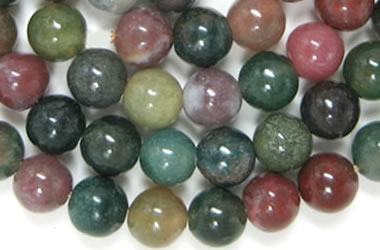
Jasper beads: Quartz is often used in jewelry or as a gemstone. These jasper beads are an example of quartz used as a gemstone.
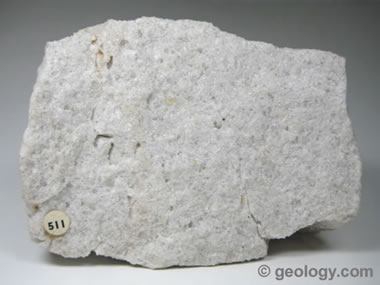
Quartz glass sand: High-purity quartz sandstone suitable for the manufacture of high-quality glass. "Glass sand" is a sandstone that is composed almost entirely of quartz grains. Pictured here is a specimen of the Oriskany Sandstone from Hancock, West Virginia. In a few locations, the Oriskany is over 99% pure quartz. Much of it has been used for container glass, but some of it has been selected for use in making lenses for the largest telescopes. Specimen is about four inches (ten centimeters across).
ADVERTISEMENT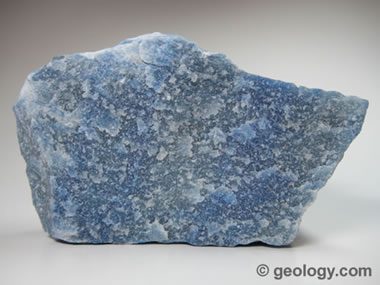
Blue Aventurine Quartz: Aventurine is a colorful variety of quartz that contains abundant shiny inclusions of minerals such as mica or hematite. It is often cut and polished for use as an ornamental stone. Common colors for aventurine are green, orange, and blue. This specimen is about four inches (ten centimeters) across and is from India.
The high hardness of quartz, seven on the Mohs Scale, makes it harder than most other natural substances. As such it is an excellent abrasive material. Quartz sands and finely ground silica sand are used for sand blasting, scouring cleansers, grinding media, and grit for sanding and sawing.
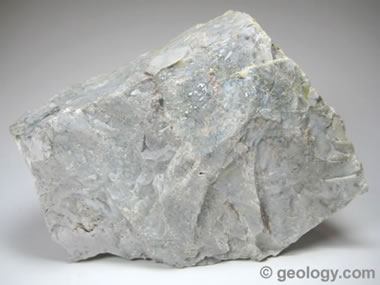
Chert: Chert is a microcrystalline or cryptocrystalline quartz. It occurs as nodules and concretionary masses and less frequently as a layered deposit. This specimen is about four inches (ten centimeters) across and is from Joplin, Missouri.
Quartz is very resistant to both chemicals and heat. It is therefore often used as a foundry sand. With a melting temperature higher than most metals, it can be used for the molds and cores of common foundry work. Refractory bricks are often made of quartz sand because of its high heat resistance. Quartz sand is also used as a flux in the smelting of metals.
ADVERTISEMENT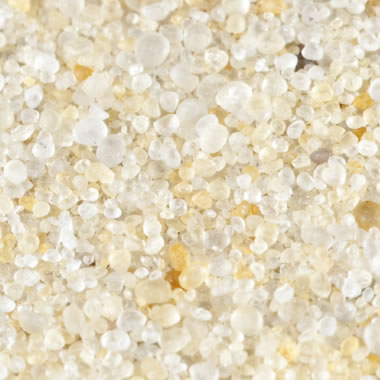
High-Purity Quartz Sand: Did you know that quartz is the main ingredient in glass? Geologists locate deposits of sand or sandstone that are composed almost entirely of quartz. Surprisingly, they have found numerous sand deposits that naturally consist of 98% quartz or more! This material is mined, processed to remove impurities, and then melted at the glass factory. The sand above was mined from the St. Peter Sandstone of Wisconsin. Photo copyright iStockphoto / BanksPhotos.
Quartz sand has a high resistance to being crushed. In the petroleum industry, sand slurries are forced down oil and gas wells under very high pressures in a process known as hydraulic fracturing. This high pressure fractures the reservoir rocks, and the sandy slurry injects into the fractures. The durable sand grains hold the fractures open after the pressure is released. These open fractures facilitate the flow of natural gas into the well bore.
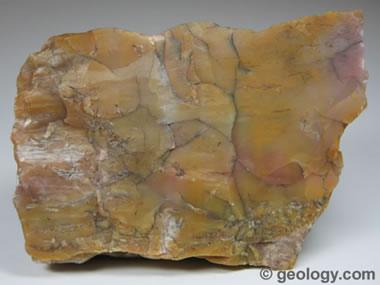
Silicified wood: Silicified "petrified" wood is formed when buried plant debris is infiltrated with mineral-bearing waters which precipitate quartz. This quartz infills the cavities within the wood and often replaces the woody tissues. This specimen is about four inches (ten centimeters) across and is from Yuma County, Arizona.

The best way to learn about minerals is to study with a collection of small specimens that you can handle, examine, and observe their properties. Inexpensive mineral collections are available in the Geology.com Store. Image copyright iStockphoto / Anna Usova.
Quartz sand is used as a filler in the manufacture of rubber, paint, and putty. Screened and washed, carefully sized quartz grains are used as filter media and roofing granules. Quartz sands are used for traction in the railroad and mining industries. These sands are also used in recreation on golf courses, volleyball courts, baseball fields, children's sand boxes and beaches.
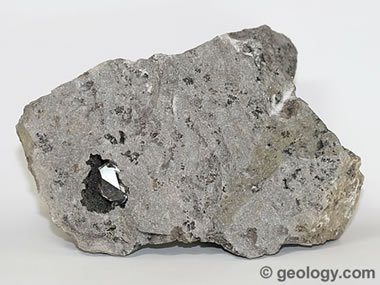
Quartz crystal: A Herkimer "Diamond" quartz crystal in dolostone. This specimen is about six inches (fifteen centimeters) across and is from Middleville, New York.
One of the most amazing properties of quartz is the ability of its crystals to vibrate at a precise frequencies. These frequencies are so precise that quartz crystals can be used to make extremely accurate time-keeping instruments and equipment that can transmit radio and television signals with precise and stable frequencies.
The tiny devices used for these purposes are known as "crystal oscillators." The first crystal oscillators were developed in the 1920s, and just twenty years later, tens of millions of them were needed each year to supply the military during World War II. Today, billions of quartz crystals are used to make oscillators for watches, clocks, radios, televisions, electronic games, computers, cell phones, electronic meters, and GPS equipment.
A wide variety of uses have also been developed for optical-grade quartz crystals. They are used to make specialized lenses, windows and filters used in lasers, microscopes, telescopes, electronic sensors, and scientific instruments. The material of beach sand is now the material of the world’s most advanced electronic devices.
ADVERTISEMENTDuring the 1900s the demand for high-quality quartz crystals accelerated so rapidly that mining operations around the world were unable to supply them in adequate quantities. Fortunately, this need was realized during World War II, and military and private industry began working on methods to grow synthetic quartz crystals to meet the special requirements of optical and electronics use.
Today, most of the quartz crystals used in electronic components and optical instruments are grown in laboratories instead of produced from mines. Most of the laboratories grow their crystals using methods based upon the geological process of hydrothermal activity. The synthetic crystals are grown at high temperatures from superheated waters that are rich in dissolved silica. These manufactured crystals can be grown in shapes, sizes and colors that match the needs of manufacturing processes. The cost of growing synthetic quartz crystals is competitive with mining, and the only limit on production is the availability of crystal growth equipment.
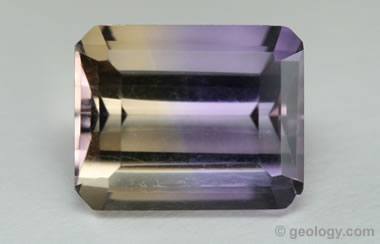
Ametrine: A bicolor stone combining golden citrine and purple amethyst. This gem measures about 8x10 mm.
Quartz makes an excellent gemstone. It is hard, durable, and usually accepts a brilliant polish. Popular varieties of quartz that are widely used as gems include: amethyst, citrine, rose quartz, smoky quartz, and aventurine. Agate and jasper are also varieties of quartz with a microcrystalline structure.
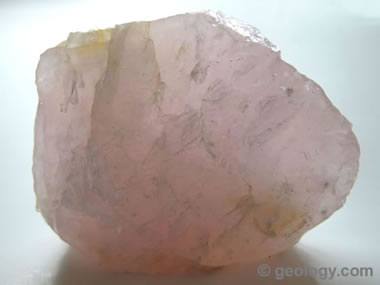
Rose quartz: Translucent rose quartz in the rough.
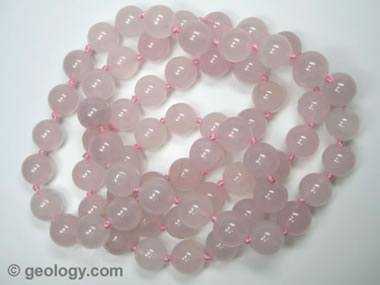
Rose quartz beads: Translucent rose quartz - cut and polished beads. Each bead is about ten millimeters in diameter.
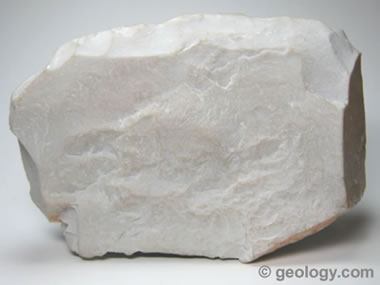
Novaculite is a dense, cryptocrystalline variety of quartz with a fine-grained and very uniform texture. As quartz, it has a hardness of 7 (harder than steel) and is used as a "whetstone" for sharpening knives.
"Silica stone" is an industrial term for materials such as quartzite, novaculite, and other microcrystalline quartz rocks. These are used to produce abrasive tools, deburring media, grinding stones, hones, oilstones, stone files, tube-mill liners, and whetstones.
Tripoli is crystalline silica of an extremely fine grain size (less than ten micrometers). Commercial tripoli is a nearly pure silica material that is used for a variety of mild abrasive purposes which include: soaps, toothpastes, metal-polishing compounds, jewelry-polishing compounds, and buffing compounds. It can be used as a polish when making tumbled stones in a rock tumbler. Tripoli is also used in brake friction products, fillers in enamel, caulking compounds, plastic, paint, rubber, and refractories.
| More Minerals |